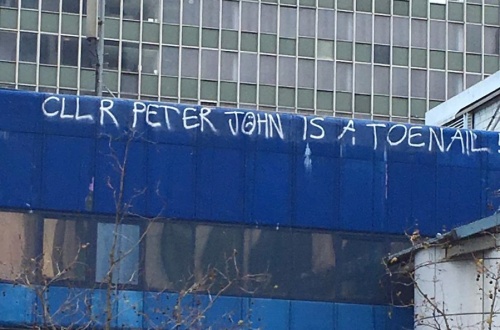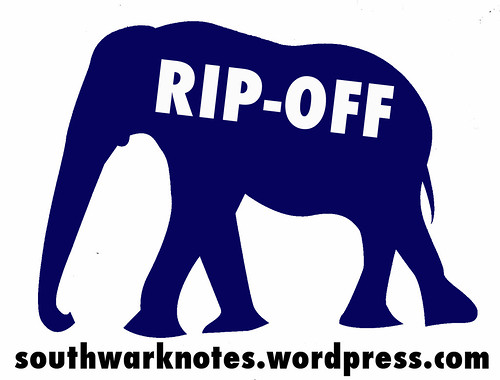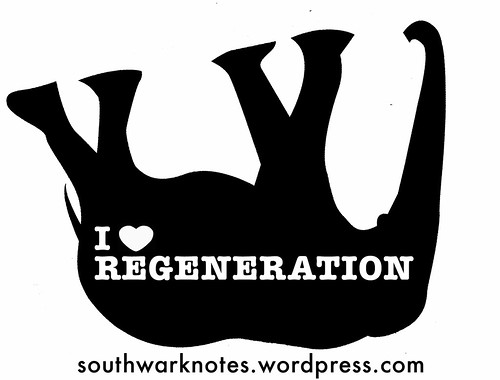In September 2020, after a decade as Labour Leader of Southwark Council, Peter John O.B.E has decided to hang up his Council Leader hat. For Southwark Notes, a small collection of local Southwark people who have been actively writing and working against the worst excesses of ‘regeneration’, we have been trotting alongside his ten-year leadership journey. It’s been a long and weary ride and it’s kept us very busy. What follows is a long three-parter. We hope it suffices as a clear summary of everything we’ve been fighting against.
Firstly, we look at the last ten years of Southwark with close reference to planning and what’s been sold off, knocked down and then built up. Secondly, we try to describe Southwark Labour in power during that decade and concentrate on how we feel that their top-down style of governing abstracts or tries to bypass any actual day-to-day actual politics that communities have to engage in to defend themselves. Lastly, we look at their claims that they are ‘municipal socialists’ and what these claims could mean if it was in any way true.
 Peter John looking at the material benefits that came to local people when the Heygate Estate was knocked down and replaced by expensive apartments
Peter John looking at the material benefits that came to local people when the Heygate Estate was knocked down and replaced by expensive apartments
If you don’t feel like reading the whole thing, here’s a summary: We add up numerous well-documented examples from the last decade of Southwark’s planning regime and conclude that this local recipe for a shit sandwich is complete. It’s a pretty damning record. A decade of the creation of literally a new Wild West gold rush for developers in North Southwark with a wasteland of luxury flats and another wasteland of overpriced and poor quality ‘shared ownership’ new builds across The Borough, Bermondsey, Bankside now reaching inwards to The Elephant, Walworth, Peckham and Old Kent Rd. Also, the struggle continues.
A DECADE LASTS A CENTURY WITH SOUTHWARK LABOUR
As the half-decent human beings that we are, we didn’t spend ten years pissing and mewling about Southwark Council just for the sake of it. The Council trumpets its free school meals programme, its new libraries, improvements to Burgess Park, free use of sports centres for residents and Southwark’s commitment to being a Living Wage employer. That all seems good and we support it. Somewhere down the line in about 2015 Southwark also came up with the idea of building 11,000 new council homes over the next twenty years or so. The Council’s demolition projects particularly at Heygate and Aylesbury Estate have already resulted in a net loss of council homes in the 1000s so it’s not a good starting point. Neither is the idea of asking or insisting that existing estates possibly lose facilities like sports courts or TRA halls or small open green spaces for infill development. With tons of development going for new richer residents of the Borough, we find it annoying that existing estates have to be the ones to give up their space and get blamed by Southwark as being NIMBY’s (Not In My Back Yard) in whose hands lay the resolving of a housing crisis not of their making. For better or worse, plans to build on top of council blocks are also being discussed. If it’s of any solace, the new-ish Southwark Great Estates Programme (2018) promises on any new estate developments ‘a net increase in social rent homes alongside increased density, to meet the acute need of families on our waiting list and a right to remain for all rehoused tenants and leaseholders, for keeping communities together‘. As ‘Regeneration’ Dept has now been re-named ‘Social Regeneration’ Dept, we are hoping the social now gets privileged over developers profits!
We also have some concerns too about the economic merit of buying newly completed homes off of developers rather than the Council finding ways to build them. So, as we have said before, we support this if it can work but the proof will be in the pudding and Southwark has continuously been baking some unaccountable shit puddings over the last ten years!
 Advert from April 2020: Elephant Park one-bed flat for £785,000 built on the demolished Heygate Estate where a one-bed flat would have cost you approx £120 per week in social rent
Advert from April 2020: Elephant Park one-bed flat for £785,000 built on the demolished Heygate Estate where a one-bed flat would have cost you approx £120 per week in social rent
So, if you’ve been a dedicated reader of this blog over the years then, you will know something of how Peter John’s decade of commitment to urban ‘regeneration’ in the North Southwark area has been a dismal ten years for Southwark. When Peter John took power in May 2010 he inherited the ‘regeneration’ plans for the Elephant & Castle from the LibDems. Wanting to look like he meant immediate business, one of the first things he did was to hastily sign a terrible deal with multinational property development firm Lend Lease to demolish the Heygate Estate. PJ said at the time ‘I’m delighted to be working with our partner, Lend Lease, to develop an area with so much potential, to the benefit of local people and for all Londoners‘. However, the real story of the mass displacement of tenants and residents has been told a million times by now and has gone down in the history books as a public housing scandal. There’s little redeeming in it for Peter John who, in response to high levels of criticism, repeatedly flip-flopped between various positions. First it was all about learning from the mistakes and saying he would never do that kind of Heygate regeneration again. Then it was about saying actually how well they had done getting tenants out of such terrible conditions as if the decant and re-housing of the tenants had been the Council’s priority all along. But if you look at Lend Lease’s expensive Elephant Park development that replaced the Heygate Estate, it’s clear that ‘regeneration’ was simply about moving mostly poor people out of the local area for no other reason than to enable richer folks to have homes on that Zone One land. It would be hard to think of many actual material benefits that the Elephant Park redevelopment scheme brought to the mostly thousands of poorer people who live at The Elephant. There is just no way a Labour council can claim this disaster as motivated by any sort of ‘municipal socialism’ even with its most piss weak ‘our hands are tied by Central government’ justifications. But more on that claim a bit later on. Yes, central government funding for local authorities has fallen by an estimated 50% in the last decade approx with very real knock on effects upon continuing rising levels of poverty, housing and job insecurity, but an increasing reliance on real estate deals to allegedly subsidise ‘benefits’ for locals can never tackle this at root.
Peter John squirms as he is wonderfully grilled out of his arse by Australian ABC TV’s Steve Cannane in October 2016 about the Heygate Estate scandal
Just down the Walworth Rd, a similar Council ‘regeneration’ scheme for the much larger Aylesbury Estate is currently underway. This time the Council made the seemingly better decision to partner up with housing associations. First with L&Q. Then with that ever-expanding and awful mega-housing association Notting Hill Genesis. The first phases have been similarly controversial with the same high levels of decant and displacement for tenants and long battles by leaseholders to not be poorly compensated for their homes. Along the way we’ve seen the same aggressive use of Compulsory Purchase Orders on leaseholders as first pioneered by Southwark on Heygate. We’ve seen endless spin about ‘benefits’ for locals and confusion about any right to return for tenants. We’ve seen ongoing under-investment and increasing shoddy maintenance of the existing housing stock. We’ve seen the standard terribly shoddy new homes that housing association homes build as their ‘affordable housing’ commitment. We’ve seen that ‘affordable housing’ shared ownership schemes are overpriced and way above the income levels of most Southwark residents. But with the current ‘regeneration’ climate now being very uncertain and new Aylesbury plans seemingly being moved in a more positive direction, the new plan, in part, seems premised on Southwark buying new homes off of Notting Hill Genesis and using these as new council homes. This will probably make Notting Hill Genesis happy as they already have 610 unsold private sale properties across London right now. Would Notting Hill Genesis even go forward with Aylesbury plans without the Council plan to buy their homes? The deal could see Southwark spend £193 million to buy 280 homes for social housing with hopefully a quarter of this stumped up from a grant from the GLA. That would make a total of 581 replacement council homes on the Aylesbury first development site.
News reports from March 2020 also stated that new Council plans could see on Phase Two ‘859 homes in total, with 287 at social rent – and could be increased to around 1,250 with a grant from the Greater London Authority’. Hard to understand any of this in actual detail yet. So, we await further news and guarantees. At the end of the day, there should be no net loss in council housing on Aylebury Estate nor tenants displaced to other parts of the Borough just so expensive homes can be built in Walworth. In the meantime tenants and leaseholders waiting to be decanted and bought out continue to live in increasingly shoddy conditions, with heating and hot water services cutting out on a weekly basis and basic maintenance being neglected.
 Up The Elephant Campaign, Latin Elephant and supporters mark the closure of the Elephant Shopping Centre, September 24th 2020
Up The Elephant Campaign, Latin Elephant and supporters mark the closure of the Elephant Shopping Centre, September 24th 2020
As we slowly write this, we’ve just seen the last day of the Elephant & Castle Shopping Centre. Once again, despite the promises of ‘regeneration’, we wonder what’s in it for local people when the Centre is demolished and replaced by close to 1000 new homes and a new London College of Communications campus. We’ve written extensively on the human cost of the closure of the Centre on local people here and here. Although Up The Elephant campaign secured an increase from 33 to 116 social rented homes of the developers, we wonder if these promises will ever come true? We have so little trust in Southwark holding developers to account or that the developers will actually build what they were given planning permission for. These 116 social rent homes aren’t on the cards until Phase 2 of the plans, so that’s donkey’s years ahead. On the vital question of genuine affordable housing in the development plans and the relocation of traders from the Centre to other sites, North Walworth councillors have been dreadful, in the main. After the planning permission was passed by Southwark in July 2018, these councilors did send an open letter to Sadiq Khan criticising the Delancey plan and asking him to ‘insist on changes which can fix these significant moral and policy failings‘ and to ‘to pressure Delancey in delivering a better deal‘. Nothing happened from Khan, of course! We suggest it might have been better to send this letter to their own Council leader Peter John who had cheer-led the whole scheme describing the measly 33 social rent homes plans as ‘on-balance…good enough’. Subsequently, those same councillors, dropped out of sight at Up The Elephant campaign meetings and became either well-meaning but useless or just plain cavalier, unreliable and pompous. To its credit, the Council officers did step up to persistent trader and campaign demands and opened up a set of garages as the new Elephant Arcade below Perronet House for displaced traders from the Centre. Despite some ongoing tensions over rent levels, lack of storage, small units etc, traders will have to see how it works out. In October this year, the Council responded well to Latin Elephant and 35% Campaign‘s call for new market pitches in The Elephant for the displaced traders who Delancey did not help get new sites. Good luck to all traders starting again in The Elephant at Perronet, the sadly ill-conceived Castle Sq pop-up shops and any new market spaces.

But, as was pointed out in July 2018 by no less than Rebecca Lury, North Walworth Labour Councillor and Deputy Leader of the Council at that time: ‘As municipal socialists we are glad the Council has come forward with a plan to support traders at Perronet House, but find little comfort in the use of public money to rectify the colossal failings of a massive private developer’. Southwark stumped up £200,000 public money to aid trader’s relocation. Again, although this support is much welcomed and came mostly from pressure from the community campaigns, these costs should all fall on Delancey. But then there was always something out of tune with Peter John and Delancey’s love song duet. Again, despite the serious and feisty Up The Elephant campaign piling the pressure on Delancey, the Council preferred to capitulate to the developers instead of using that very public strength of the campaign as leverage to actually secure real benefits for their constituents.
STRANGELY, THEY (PROBABLY) ACTUALLY BELIEVE IN WHAT THEY ARE DOING?
Ok. You’ve made it this far. Well done! Hold on to your hats as we are about to board the rollercoaster of reflection as we look back at some of what we think has made Southwark so awful over the last ten years.
As local people, working alongside the amazing groups like 35% Campaign, Latin Elephant and Up The Elephant, we’ve been digging in together to highlight again and again in detail how Southwark operates – highlighting how ‘consultation’ of local people is entirely bogus and works to deflect from their social concerns or how seemingly participatory ‘co-design’ processes still offer only the illusion of being listened to. A report by Social Life entitled ‘Understanding Southwark Daily life and the impact of COVID-19 across the borough – First phase of area-based qualitative analysis: Key Findings’ (October 2020) interviewed numerous local Walworth and Elephant people and found that ‘Residents and traders reported low levels of voice and influence in local areas, the reasons for this varied. There is a widespread cynicism around consultation and the impact that local voices have on local decision-making, particularly among people with fewer resources (in time and money) and BAME groups. It was widely noted that opinions about new housing developments polarise feelings in all six areas‘). We’ve all been highlighting how developers use viability assessments to spin why they can only provide low levels of ‘affordable’ housing in their schemes and despite Southwark policies for 35% affordable housing for big developments the Council relentlessly passes non-compliant schemes. We’ve been banging our heads against a wall as Southwark again and again allows planning permissions they have granted to be flouted and social rented homes built and offered as the more expensive ‘affordable rent’. We been watching dozens of councillors and high ranking council officers leave the Council to take up employment with developers or planning consultants. We’re seeing the Council sell off asset after community asset – land, council homes, Town Halls, children’s homes, health and day centres.
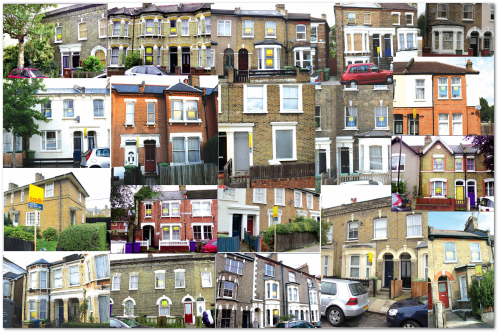 Government statistics show that Southwark has sold off over a thousand council homes in the five years from 2010 to 2015. Source: 35% Campaign
Government statistics show that Southwark has sold off over a thousand council homes in the five years from 2010 to 2015. Source: 35% Campaign
Interviewed in May 2010, just before taking power in Southwark, PJ commented that ‘the first thing we’d do is not sell off our existing stock‘ yet the Council continues to auction off family-sized homes year after year to this present day. Although this policy was introduced by the previous LibDem/Tory regime in Southwark, the Labour Party in power reduced the previous over £400,000 value threshold for sale to over £300,000 value threshold for sale. Prize historical public assets like Camberwell Town Hall were also sold off in December 2014 to an offshore -based developer; Bermondsey Town Hall was sold off in December 2012 to developers and the make over of the fire-damaged Walworth Town Hall has been contracted out to private developers in 2019 despite two Council consultations were local people clearly stated they wanted the Council to keep the Town Hall as a real public asset.

 Summer 2018 – Southwark Council agrees to sell off two plots of its own freehold land close to Old Kent Rd for developments
Summer 2018 – Southwark Council agrees to sell off two plots of its own freehold land close to Old Kent Rd for developments
At the same time, the Council now complains about how land values are too high in the Borough and prevents them from purchasing and ‘re-municipalising’ land along Old Kent Rd for their new council home building programme. Leo Pollak, Council Cabinet Member for Housing writes ‘in the midst of a land speculation frenzy—a Great South London land rush—our job as builder and as planning authority in maintaining the link between real-world housing needs and housing supply in our borough is made unnecessarily difficult…an unregulated market for land creates a ratchet effect that treats planning permissions and site allocations like any other kind of tradeable commodity, dissociated from the council’s imperative of meeting local housing needs, securing sums for social infrastructure and ensuring good growth’ *. This is literally the speculative development and land-banking gold rush landscape Southwark have been laying the ground of in the last ten years. We find it hard to make sense of what Southwark does in this respect. Right now, Southwark is busy buying up lots of parcels of over-valued land along Old Kent Rd and yet only two years ago it sold two large pieces of land it owned at Mandela Way and Devonshire Grove, off Old Kent Rd!
 Housing Action Southwark & Lambeth regular meeting
Housing Action Southwark & Lambeth regular meeting
On another tip of local people dogging the Council’s shonky decision making, the excellent group Housing Action Southwark and Lambeth (HASL) have done dogged casework for people and securing them council housing against Southwark who were consistently gate-keeping applicants from applying. HASL also do top work on tackling overcrowding, temporary accommodation and Southwark’s terrible way of dealing with actual sentient living feeling humans being in distress. Southwark Group of Tenants Organisations have been great at highlighting how current Southwark plans to re-jig democracy and accountability to tenants are likely to result in less structures to try and have a voice on and say in Council plans.
This all adds up to what then? That the Council’s ideological commitments to ‘regeneration’ and rebalancing the social mix – otherwise know as social cleansing or gentrification – are what has made Peter John’s decade at Southwark the most famous. Whether that’s the terrible deal they made with Lend Lease for the Heygate or the disgusting cheerleading and outright brown nosing of offshore-based, tax-avoiding developer Delancey for the Elephant Shopping Centre scheme or the current disaster-to-be of the Southwark fuelled gold rush for developers along the Old Kent Rd, this is all just more long-term social cleansing in action. We’ve written about this a lot here. Oh, and don’t even mention the massive Canada Water ‘regeneration’ plans at Surrey Quays!
But it’s not just us banging on about this. In 2016, Southwark Giving released a detailed report called ‘A Tale of Two Southwarks’. It was an independent research report into the needs of local communities in the borough of Southwark. From the title you can see that they were concerned about and highlighted the effects of so much private market housing in the borough. They wrote: ‘The difference between affluent and deprived areas is becoming more prominent in Southwark, with areas on or near the river and in the south becoming increasingly unaffordable whilst the areas in the middle of the borough are becoming more deprived…Redevelopments and new businesses attract higher-salary workers to some areas which lifts the local economy but leaves other areas stagnating. While average earnings in Southwark have risen with the influx of new industries, this has not benefitted all workers. Nearly one third of households in Southwark earn less than 60% of national median income after housing costs; this is the fifth largest proportion of households in inner London boroughs. 4,509 individuals received help from the Southwark Foodbank in 2013/14 (roughly 1.6% of the borough’s total population). Poverty is not the only decider of life chances and opportunities. Other issues can divide Southwark’s residents into ‘two cities’ based on: gender, age, ethnicity, income, housing, health, wellbeing, education, employment, and membership of a minority group’.
This mirrors everything all the local campaigns have been saying and actively fighting against for years – that Southwark’s planning and development policies consistently favour large developers and large developments that lead to further poverty, dispossession and displacement. Once again this is not rocket science. The effects are very clear if you live on the poor side of things as most of us do. You see the effects everyday.
 Land value and speculation – how it works: Empty site Blackfriars rd & Stamford St. Land Securities bought most of the site in 2003 for £38 million. Israeli-backed Circleplane buy the site as £90 million in 2007. Malaysian-backed, Jersey-registered company Black Pearl in 2014 for £114 million. Hero Inc. Ltd, Staycity Ltd and BSW Land and Property Ltin 2019 for £235 million.
Land value and speculation – how it works: Empty site Blackfriars rd & Stamford St. Land Securities bought most of the site in 2003 for £38 million. Israeli-backed Circleplane buy the site as £90 million in 2007. Malaysian-backed, Jersey-registered company Black Pearl in 2014 for £114 million. Hero Inc. Ltd, Staycity Ltd and BSW Land and Property Ltin 2019 for £235 million.
LUXURY POLITICS WITH EVERY LUXURY FLAT
Our face-to-face experiences of Peter John are thankfully few and far between. The ones we did have were indicative of the full range of his style and panache. Firstly, when we organised a silent visual protest inside the Council planning meeting that would pass the Masterplan for the demolition of the Heygate Estate in January 15th 2013, PJ was outraged by the community members holding up critical posters. Close to the end he snatched a poster out of one of our hands and put it on the floor and got all grumpy faced. Pretty funny.

Secondly, we witnessed the literal duet he performed at the Borough, Bankside and Walworth Community Council meeting on 9th January 2018 with Investment Director at Delancey Stafford Lancaster. Both of them sang the praises of the Delancey scheme to the high ceiling of St Peters Church. Stafford took on the verses whilst PJ did the well-worn choruses: ‘People don’t like the fact that a private developer is involved or that private money is going to have to pay for the redevelopment of the Centre and that they are a company with investors and shareholders and they allowed to make profit and that’s their business, that is the reality of their world and our world’.

Peter John croons ‘What Kind of Fool Am I?’ to Delancey’s Stafford Lancaster, 9th January 2018 at the Borough, Bankside and Walworth Community Council meeting.
But only a very chosen few get to join in the sing-song. What’s obvious from the decade of Peter John’s reign is how he always maintained the luxury of not answering any awkward questions from people who desperately needed answers and input into things that affected their lives, their survival. Meanwhile, he was selling Southwark cheap at a property trade fair in sunny Cannes in 2013 and promising as many luxury flats that the borough could cram in. Different shades of luxury, we suppose. No doubt he was telling the story over canapés of how they had decanted all the tenants on the Heygate to make way for such luxurious property development. With Cannes always on our mind, there was always the amusing spectacle of his official Gifts and Hospitalities logged at Southwark’s website. A £50 quid lunch here with Chris Horn, six years as Southwark Council project director of the £2bn Elephant & Castle regeneration before he launched his own ‘affordable’ housing development company Enter Homes. Or a nice dinner there at Pont de la Tour with Bell Pottinger Group. This dinner was handy as the restaurant was 5 minutes away from PJ’s then swanky apartment in posh The Circle development in Shad Thames. It was to be one of nine such meals with Bell Pottinger or Peter Bingle or latterly Terrapin Communications. Who they you might ask? Only the UK’s must dubious PR and Comms firm who were caught in 2011 boasting how it uses ‘dark arts’ to bury bad coverage and influence public opinion. Clients include multiple shady dictatorships, the arms industry, the fracking industry, the gambling industry, the tobacco industry etc. A strange repeat dinner company for a socialist Man of the People, like Peter John O.B.E.
The dinners with developers flowed like fine wine and developers built stuff in Southwark. Sure, as Leader of The Council, you expect a certain amount of meeting property developers but there are meetings and then there are meetings! We always presumed that Peter John actually had an office at Tooley St to meet people in but maybe he was forced to hot-desk at local restaurants. We love to quote the old Workers City line and we’ll do it again here:
‘When developers visited the City, the used to creep in at the side door, now the councillors bring them in the front door, one on each arm’. Not only had it become respectable for councillors to be seen with developers, it soon became imperative to be involved with them. Indeed, it got to the stage where councillors and developers became indistinguishable. The only real way they could be told apart was that the developer was always talking and the councillor was forever nodding his or her head’.
From ‘Glasgow’s Not For Sale’ by Brendan McLaughin (1990).

Peter John, leader of Southwark Council, and Lend Lease EMEA CEO Dan Labbad sign off the destruction of 1000+ Council homes on the Heygate Estate, 23rd July 2010 in Southwark’s Tooley St HQ. Smiles all round!
Of course, the fine dining and the quote points to how much of the Labour party has changed over the last 30 years. Peter John is pretty typical of many other London Labour council’s regimes and we’re thinking of Croydon (currently going bankrupt!), Lambeth, Lewisham – all Blairite-fuelled dynasties of reactionary PJ type-clones. Some of us Southwark Notes lot are former Labour voters and if we weren’t on a more radical tip and disbelieving that party politics will do anything for us all, we would still vote Labour because we were brought up to be Labour. That bringing up instilled in us some class-consciousness and had us believe that Labour was the party of the working person. But Peter John and others should have no illusions about what having a Labour mandate means in a massively solid working class area like Southwark. You could stand a turd with a red rosette stuck in it round here and it would be elected for the rosette and not the turd. Voting for a red rosette though doesn’t mean people then want to see a load of alienated posh people colonise their traditional stomping grounds. But it also doesn’t mean local people don’t want change or even regeneration. Of course, they do, if they’re actually centered at the heart of it.
SOUTHWARK’s SECOND CLASS POLITICS STRICTLY IN THE POST
‘…from this moment forward to think and speak the language of those who govern, no longer the language of those who are governed. They spoke in the name of the government (and as part of it), no longer in the name of the governed (and as part of them). And so of course they adopted a governing point of view on the world, disdainfully dismissing (and doing so with great discursive violence, a violence that was experienced as such by those at whom it was directed) the point of view of those being governed… The most that any of them would deign to do would be to replace the oppressed and dominated of yesterday—along with their struggles—with the “marginalized” of today—who were presumed to be of a passive nature. They could be considered as the silent potential recipients of the benefits of various technocratic measures that were intended to help the “poor” and the “victims” of “precarity” and of “disaffiliation.” All this was nothing other than a hypocritical and underhanded strategy meant to invalidate any approach to these problems that used terms such as oppression and struggle, or reproduction or transformation of social structures, or inertia and dynamism within class antagonisms’.
From ‘Returning to Reims’, Didier Eribon (2009)
It has been a long and ever bumpy ride for those who have been active for any number of years against what is called ‘regeneration’. Decades ago the Tories cut Central government allocations and Councils were forced into local competition with each other for funding. New Labour brought an emphasis on partnerships where developers, councils and local community all appear as ‘stakeholders’. In these so-called partnerships decision making power is weighted heavily on the side of developers first, compliant and desperate councils second and lastly for us locals where community involvement via ‘consultation’ is toothless. What actually takes preference with such a planning regime in force, is that social questions – what do working class communities need? – arrive last place to questions of economic growth and development. This has been summed up well by urban writer Guy Baeten in a 2009 piece about the regeneration of The South Bank in London. He says ‘Regeneration efforts, exclusively conducted through the institutionalised channels of partnerships and governmental grants, create a singular discourse about what regeneration should be about, and reduce any alternative regeneration view, expressed by whomever whenever, to sheer background noise’.
 New Labour flagship Tony Blair declares that no-one will be left behind in 1997 but by 2020 the Aylesbury Estate was being demolished by Southwark Labour
New Labour flagship Tony Blair declares that no-one will be left behind in 1997 but by 2020 the Aylesbury Estate was being demolished by Southwark Labour
Not only did Southwark Council join in the fan club for partnerships, they also dove head first into the mire of New Labour Blairite thinking on what we can term ‘the political’. Although there was a ‘New’ in ‘New Labour’, it also never really escaped the heavy top down mix of old-fashioned Right-wing Labour paternalism – ‘we know best’. Classic 70s/80s Old Labour in Southwark ran as a kind of semi-benevolent mafia acting in the alleged interests of their working class constituents but always from on high and never asking what people needed or wanted. But the New Labour thinking continued this paternalism but with the class politics removed because they believed that politics as politics was over. New Labour ideas and policies actually remove the political from local government and local community demands. By the political, we simply mean the cut and thrust of community demands to local government to defend what they have – council homes, youth clubs, open spaces, local shops, nurseries, estate repairs, TRA funding and maintaining some kind of power in actual decision making or demanding it through protest and sometimes occupations. For New Labour, that kind of day-in, day-out community-activated fuss, dissent and righteousness became seen as something in the way of them just making decisions that affect people’s lives and survival. No longer were community voices and channels seen by the Council as a part of a wider Labour movement but they became to be seen as something negative and thus could be written off through the disingenuous stroke of saying that these local voices were not representative, responsible or ‘positive’. Community members saying ‘No’ to things were viewed as illegitimate because Southwark wanted to move forward in partnerships with developers and the community should be happy with what was promised from that unholy alliance. What’s worse is that dissenting voices are then portrayed as politically motivated which, of course, they are. Politics is the public moment of fighting for your best communal interests! But for Southwark being ‘invited’ to the table is more about some kind of powerless ‘Community Conversation’, as they termed it at one point. In all reality locals are just being ‘included’ to tick a box of community involvement and not to listen to their actual political beliefs. It’s just an illusion, a bureaucratic acknowledgment of presence but not your arguments. These new leaders in the Labour Party don’t believe in helping to build confidence, self-belief, identity and personal growth in people so that they can be active on their own behalf. All of these things are what parts of the socialist movements have tried to do over time. The anarchist planner and writer Colin Ward wrote in the 70s about ‘a tendency towards bureaucratic paternalism and alienation in public landlordism, which he believed treats tenants like ‘inert objects’ rather than active subjects….housing was done to and for people rather than by them’ (**). Many Southwark council
tenants would know the feeling. We certainly do!

Aylesbury Estate tenants protest at continued breakdown of hot water and heating, February 2019
But despite this attempt in Southwark for the Council to inhabit and operate in what has been called the ‘post-political’, there has been an enormously feisty and determined coalition of people fighting the worst aspects of Peter John’s Labour ‘regeneration’ regime. At Southwark Notes we’ve long recognised and mapped out how such a post-politics might attack at the roots and legitimacy of community organising and campaigning and we didn’t step into that swamp by trying to be nice and cuddly. We long recognise that politics is necessarily antagonistic to power and that you won’t get very far trying to sit at the same table of power. We would rather stand on top of the table and say ‘No!’ or be lurking underneath sawing its damn legs off.
Needless to say, Peter John was always ready to denounce us and others as ‘keyboard warriors’, as people entirely unrepresentative of what local people wanted or as outsiders and so on. For sure, we aren’t deluded enough to think that we stand for what all local people think but in those ten years we’ve certainly found a massive resonance locally for what we say and do. But Peter John is the perfect ‘post-political’ operator. He plays that patronising role of ‘the adult in the room’ perfectly. Nothing radical or experimental or challenging can be allowed in. It’s the politics of pragmatism, of paternalism, of ‘we know best’. Rather than forging a shared politics of resistance to challenge the economic logic that privileges real estate as an alleged driver of people’s well being, he holds tightly on to a ‘politics of the possible’. Yet without some kind of radical vision, what is possible is only to open up Southwark more and more to the violent actions of development under the guise of ‘progress’. For people like us who believe in something a bit more, something maybe a bit more impossible, he relies on the luxury he has to close down any arguments by having a final word then retreating to silence.
For example, despite one of us at the time actually living on Heygate in its final years. Despite us working with 35% Campaign who were organising with Heygate residents and families yet to be decanted and despite us actually originating the now famous Heygate Displacement maps that showed how many tenants and leaseholders had been forced out of the area. Despite all this, Peter John could still publicly assert that when he became Council leader in 2010 ‘there were six families still living on the Heygate. I met each of them and ensured their needs were met’. There is a well-known non-post-political phrase and saying you could apply to this statement– Patently Bollocks. A good time to recall here then his one time awesome rebuff to someone who was questioning PJ. He replied that the reason he knew what he was saying was correct was, quote, ‘Facts!’.

Peter John demolishing all critics in his ‘Facts’ JCB
Or, do you remember when we leaked the secret Southwark and developer Lend Lease regeneration agreement to the press and when this was later featured in a withering rebuttal of all of Southwark’s Heygate spin by respected Guardian journalist Olly Wainwright in June 2015, and Peter John publicly denounced the article as ‘#crap journalism’. End of story for Mr Peter John. Nothing had been done wrong. There was no scandal. It was just ‘crap’. As we have said above, when PJ was publicly called out on a lie by us and others, he hunkered down in his Tooley St bunker and discussion or debate was then taken off the cards. This is the perfect post-political manoeuvre. It attempts to maintain the narrative until the very point the narrative is shredded by campaigners, then to go silent and withdraw from any actual argument because campaigns are just being ‘political’.
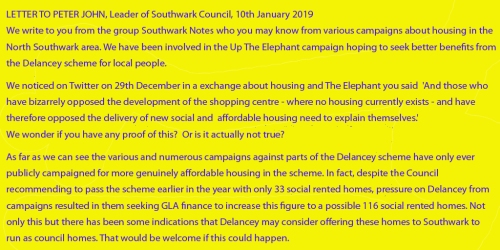 Letter to Peter John was was publicly lying about Up The Elephant campaign pretending that the campaign was prventing new affordable homes being built when the Campaign had secured 116 socail rent homes against the Council-approved 33! (January 2019 and we are still waiting for a reply! *-)
Letter to Peter John was was publicly lying about Up The Elephant campaign pretending that the campaign was prventing new affordable homes being built when the Campaign had secured 116 socail rent homes against the Council-approved 33! (January 2019 and we are still waiting for a reply! *-)
For years now we have been calling Southwark’s frequent use of this tactic – ‘The Void’. We’ve written about it here at length. From our own perspective and ideas of community politics and organising, The Void makes things very hard for us. Despite years of hard campaigning, the simple fact remains that communities and community groups have just so little power to force change means that we have not been successful in defeating the rapid social cleansing at hand. In the realm of post-politics, where community campaigns are de-legitimated, we spent far too much time actually legitimating politicians and developers and recognising them as equals in some sort of polite liberal conversation where we often expect them to do better or to finally have an epiphany and do the right thing. But this will never happen. Ruling Labour politicians, who neither come from where we do economically and often culturally, are ideologically committed to a capitalist realist approach of there being no alternative to private market-led development.
The problem of normal ‘politics’, especially as we experience it in 2020, is that it appears totally legitimate even when it beggars belief as to what is going on. We are supposed to believe in politics, in Parliament, in the economy, in fictions of fiscal prudence and austerity and that we will need to tighten our belts some more as skinny as we actually are these days! Labour is complicit in this as much as Tories. We had some time for the Corbyn project even if, at best, it was only a limited social democratic possibility for tackling inequality in society and not any kind of actual socialism that would take on changes at a basic and deeper structural levels and roots. By this we mean dismantling profit, the free market, how we conceive of work AND everything else, that is, actual radical society-wide change. Not easy, of course, because you can see how much The Establishment will destroy anyone who even brings limited challenges to the deep structures of societal power and inequality. Right now, even though that moment is over, they are literally prepared to eternally salt any ground ever walked by Corbyn just in case the rest of ideas get any funny ideas again of changing things even at the most reformist level. In Southwark, that Corbyn moment produced a handful of actually Left councillors and push to take more power but the whole structure is the mess really. Party politics? We would say it’s irredeemable as a vehicle for the deep structural changes we need to make.
NO IRONY MUNICIPAL SOCIALISM
Back to the paternalism of Southwark Labour in power and that despite what we’ve outlined above, they still call themselves ‘socialists’. There’s little irony lost on us about how if you were to look at, for example, the Militant Labour council in Liverpool in the early 80’s, you would see the same top down ‘we know best’ attitude but from a totally different political perspective. In Liverpool, the Militant-led council worked from the position of ‘municipalism’, this being that the Council is what leads the defence and advancement of the city’s working class needs. They built a lot of council homes but they also attacked working-class people’s setting up of actually community-controlled housing co-ops because they saw them as undermining their municipal role as guardians of working class interests. Paternalism always!

Private homes built by big builder Bellway Homes replace 113 council flats demolished on Elmington Estate in Camberwell, 2018, and Government ‘Help To Buy’ scheme inflates the value of the new homes. In total 346 council homes lost in Three Phases of Elmington ‘regeneration’ (2005 – 2018)
In a May 2018 interview with Peter John on the SE1 website, we can read that ‘his party’s programme for the borough is rooted in “old-fashioned municipal socialism”’. We find this a somewhat bizarre claim for many reasons. Given that any high points of the varied UK histories of municipal socialism always involved a politics based squarely in working class interests, there would be very little to recognise in the last ten years of Southwark Labour that resembles what we take socialism to mean – the social ownership of production and distribution, democratic decision-making structures, participatory planning etc. Instead what we get is a bowing down to the free market to provide, purely as a legal concession, tons and tons of ‘affordable housing’ that everyone knows isn’t affordable. Peter John talks a lot about needing to help the ‘squeezed middle’ but can’t grasp that that granting planning permissions time and time again to big home builders doesn’t mean that more homes are available at affordable prices. All it means is that these new homes are just part of the increasing unaffordable and often Government-subsidised home ownership landscape. ‘Affordable housing’ such the ubiquitous ‘shared ownership just keeps house prices artificially high against continued depressed wages. This is not providing much relief to the squeezed middle, in fact, it’s just adding to their continued squeezing as big homebuilders profits go through the shoddily built roof. Peter John’s great statement in January 2018 that ‘in a housing crisis, you need to build houses’ is both naive and absurd. Allowing big developers like Taylor Wimpey, Barratts, Bellway etc to build new homes in great number will never be some magic rebuttal of the building industry’s tight control of what gets built. It’s a fallacy that lots of new homes drive the price of housing down. Peter, show us anywhere in the U.K where this is happening? Supply and demand is a free market myth. In the excellent new book ‘The Property Lobby’, Bob Colenutt nails it clearly when he says that studies ‘have shown that developers routinely drip-feed new housing units onto the market in order to keep up house prices…property investors need the housing crisis to continue in order to ensure the flow of profits into their business. The gulf between the world of property investment and the reality of tackling the housing crisis could not be wider‘.

Ten years of benefits for local poor people and the ‘squeezed middle’ as property prices rise 103% in ten years at The Elephant
For a ‘socialist’, PJ doesn’t understand the basics of capitalism very well! If they actually found some municipal socialist gumption they might actually play and inspire some kind of way forward for local government to contest the situation the Council finds itself forced into by central government. For their paternalistic sins, Left-wing councils like Liverpool and Lambeth and even Southwark did attempt to defy Tory cuts in the mid-80’s. But then current Southwark Labour are toothless fighters with no class position and so they oversee cuts and don’t fight. We aren’t suggesting this is all easy as pie but if you don’t try, you never find out. The Labour municipal socialists running Red Bermondsey in the 1920s unleashed a wild socialist programme based on well-understood needs and demands of locals. To do this they actually asked around in chapels, churches, settlements, parents unions, trade unions and so on what people wanted and acted accordingly. This wasn’t ‘consultation’. It was a dialogue. It was listening. It was building small socialisms in as much as it could. They also had to fight a Labour government who were keen for them not to expand a socialist alternative to landlords, ill health and so on!
 1930’s Red Bermondsey when they weren’t afraid of being against capitalism
1930’s Red Bermondsey when they weren’t afraid of being against capitalism
But instead of going down the road of conflict with the Tories, we get bullshit. Take the example of Southwark’s critical letter to the government about the ConDem government’s introduction of ‘Affordable Rent’, a tenure that allows for ‘affordable housing’ to be rented out at up to 80% of local private market rents. Despite their letter’s concerns, time and time again Southwark gave planning permissions to developments that included a few social rent homes, but when completed, the social rented units were switched at the completion stage by the developers to ‘Affordable Rent’ units. In 2016, the 35% Campaign referred Southwark to the local government Ombudsman about dozens of examples of this switch. The Ombudsman ruled that Council didn’t know how much social housing it was getting from developers.Despite some Council casework on this, it’s clear from the 35% Campaign’s continued work on this that there is still no actual decent system of checking up on what they had actually agreed to in their Section 106 agreements. Just for the lolz, that literal full bottle of clown sauce Councillor Martin Seaton recently remarked how ‘robust’ he will be as current Chair of the Planning Committee yet is still fine to act surprised that this is happening and then asks locals to point out where ‘affordable rent’ is delivered instead of the agreed ‘social rent’. 35% Campaign have been informing the Council of these switches for years! With a housing waiting list of many 1000s there is a desperate need for social rented homes in the borough. Letting developers switch tenure isn’t even defending the tiny gains you make as a planning authoritywhere via Section 106s you try to grab as much social rented housing as you can. Worth pointing out that a vital part of the expansion of municipalism globally has been to develop accountability for local people by opening up oversight of public office. 35% Campaign’s dogged research work does actual citizen’s scrutiny far better than anything Southwark would ever be willing to implement as ‘municipal socialists’.
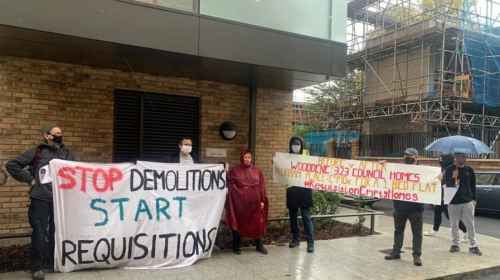 Southwark Defend Council Housing protest outside the new Notting Hill Genesis Peckham Place development on 31st October 2020 where over-priced flats have not sold
Southwark Defend Council Housing protest outside the new Notting Hill Genesis Peckham Place development on 31st October 2020 where over-priced flats have not sold
The of the biggest questions we have for the Council is what happens when the Southwark model of ‘affordable housing’ provision, premised upon being financed by a cross-subsidy from developers who you allow to then build massive private home development, fails because the housing market is a mess or because planning is deregulated further by those in power taking away such planning gains? The Government ‘Planning for the Future’ white paper published in August 2020 signal plans for further deregulation, further privileging of developer’s needs, marginalisation of community groups and a call to replace the Community Infrastructure Levy and Section 106 payments. So what supposed ‘municipal socialism’ are you left with when you are already a part of that privileging developers but less power, less assets, less land and less control of development in your borough. How is this municipalism? In the last decade Southwark has essentially overseen a massive transfer of public assets into private hands. Literally expanding private wealth at the cost of the public purse and the effects of these polices impacting most heavily on the most marginalised and dispossessed people in Southwark – women and Afro-Caribbean, African and Asian community members. The Council literally have zero understanding of the most basic ideas of how poverty is reinforced and how displacement occurs.
We have little doubt that Southwark’s ‘municipal socialism’ just sounded good in 2018 when they were bandying it around. Seems to be more a reference to older models rather than any of the new style attempts globally at actual citizen-led movements in local democracy. There has been no attempt by Southwark for the redistribution of power, community wealth building, new forms of democratic municipal and citizen ownership or ‘growing local, socially rich economies, with fair wages, cooperative ownership models, more local enterprise, unionisation, greater worker control, and genuine social value and environmental responsibility’***. That they were saying ‘municipal socialism’ at the same time as the Corbyn moment stinks even more as Peter John was never a fan of what actually might have been possible for the Labour movement (as such) if Corbyn had taken power. Even then we would still be facing both a hoovering up of social movements to bolster a Left-ish Labour party in power plus the fact that the Corbyn project would have had very little room to move to actually bring about any real structural change. Parliament might legislate but the power remains with the boss class. The rich and powerful don’t just give their money and power away. You have to take it off of them. Will party politicians ever lead that fight? You already know the answer.
WE MAY BE STUPID BUT WE ARE NOT THAT…ETC ETC
So, really, it would be silly of us to expect any radical socialist challenge to actual structural inequalities in Southwark’s new found liking for municipalism. Seems more likely to be more glibly inspired by the recent comeback of the term in the last few years even if places like Barcelona or Preston are actually, if messily, putting it into practice some slightly radical actions contesting the excesses of contemporary capitalism. The city governments in an informal global network that produced the ideas and policies in Fearless Cities model are worth examining and, for sure, we have been doing this quite closely. Once again though, we would take some time to look closely at these examples and warn, as many other social movements have, that if these Councils really do ground themselves in what they have learnt from actual grassroots street and city campaigns and movements, there is always the danger that these bottom up movements are then either politically de-clawed by participation with local government or are professionalised into weedy but salaried NGO-style bureaucrats. There are hints right now that Southwark wants to woo local groups and campaigns into supporting weedy petitions to ask the Tories to be nicer to local government and be nicer about excessive land values. There is also talk of Southwark establishing a Council-run Renters Union even though HASL already exist locally and despite the growing London Renters Union! Again, we aren’t critical for the sake of it. We just value the critical and practical autonomy built up in the informal community networks we have been a part of for a decade. For real we would work with any decent local councillors. We’ve just failed to find any, and it needs say loudly, it shouldn’t be like this!
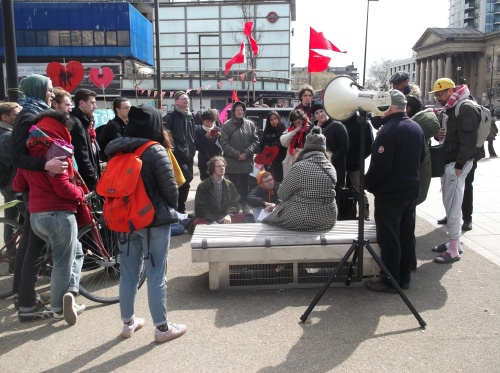
Teach out and assembly, Love The Elephant – Hate Gentrification gathering, April 2019
It’s sad but true that the UK has always lacked the popular movements that we can find in Spain and other countries where local assemblies produce a very local participatory and active way of organising for better housing, against evictions and against rampant speculation in their neighbourhoods. The UK tradition is far more rooted in antiquated organising forms like big unions and local Labour parties. Sure there are good folks in both of these ‘movements’ but the form is always hierarchical and premised on pragmatism and compromise. These forms might have some energy for campaigning but they do not really give space and support for actually autonomously organised movements. We seriously think this is one of the key points all future organising has to look at – that despite long standing labour traditions, the working class have rarely broken with parliamentary party politics or, if they have they’ve then been inevitably stitched up out because the very function of both political parties and big unions is to maintain the social contract between workers and bosses and to keep the peace and let capitalism do its thing. Interestingly, the book Workers City that we quote above has an excellent short article that details a time and a place and a set of ideas where parts of the UK working class did begin to organise from below, against union and party hierarchies and, more critically, against Parliamentary politics and mere representation of their demands and needs.
Radicals have been saying for years that the main problem of municipal socialism is that it always ends up maintaining social peace, forging class conciliation, and thus diverting public attention away from the fundamental questions of the economic system as a whole.We agree with that 100%. Even if we might also prefer a reform or two, here and there, over more violence brought by government onto the head and hearts of working class people and even if we are happy to work with any kind of councilor who you hope might be any good but we’re still in more favour of the creation of groups and federations of working people, coming up with the own ideas and organising practices outside the control of politicians or professional campaigners.
 Los Angeles Tenants Union, only five years old and already built 13 union chapters across LA and still insisting on autonomy from NGO’s and political parties!
Los Angeles Tenants Union, only five years old and already built 13 union chapters across LA and still insisting on autonomy from NGO’s and political parties!
Endlessly, we would point people to the amazing principles and success of the Los Angeles Tenants Union since its setting up in 2015. Sadly, inspirations often come too late. We would have loved to have had the energy to set up at The Elephant something along these organising lines to add a spicy take to all the good work being done there by other campaigns. As Southwark Notes, we remain committed to relationship building with others, trying to spread confidence and energy, trying to build mutual support and cooperation, always sharing what we learned, always listening to what others have learned and publicly acknowledging mistakes we made. Of course we are well active against the current government rather than spending all our energies on Labour and letting the Tories off the hook. Imagine if the big unions and Labour were publicly calling workers out and organising nationally and locally en masse against the cuts, against the privitisation of public health, against evictions, redundancies…imagine that? Sure, there are piecemeal struggles going on but the thinking is never joined up and never mobilised on the basis of our anger.
In passing, we still take inspiration the independent unions United Voices of the World (UVW), the Independent Workers’ Union of Great Britain (IWGB), the UK’s branches of the Industrial Workers of The World (IWW) and the Cleaners & Allied Independent Workers Union (CAIWU) and all of their direct action rank and file style organising. Exciting too is the current discussions in London Renters Union and ACORN branches about the scale and difficulties of a rent strike tactic over a rent reductions strategy as well as good tensions being explored around how a movement moves rather than functions as a service for members. These are great dynamics at work and a sign that such politics are fresh and can win victories. We are also supportive of the slowly expanding Mutual Aid groups and Solidarity Funds network in South London (Rotherhithe, East Dulwich, Peckham, Deptford, Herne Hill etc).
STUCK IN A LIFT WITH PETER JOHN
Finally! There’s an infamous story Peter John tells about when he and MP Harriet Harman visited the Aylesbury Estate where allegedly they were in a lift and a man was injecting drugs into his penis. PJ says ‘That’s not a sign of a successful community. That’s not the kind of community we want to see’. Rather than understanding that a drug-injecting user is a human being struggling in life, he uses this individual’s story at that moment to denigrate an entire community. Such a lack of understanding betrays his political values – that instead of asking how a person is failed by society, he weaponises individual trauma to justify the Council demolition and ‘regeneration’ of The Aylesbury. How demolishing 2700 council homes remedies any of these common working class social problems, we don’t know!
Such reactionary narratives are well described by the writers Rob Imrie and Mike Raco: ‘Communities, then, are portrayed as a pathological underclass, entities that inculcate individuals with immoral values, but they are at the same time a source of moral good that is being corroded – something that needs to be rectified through regeneration’. PJ sees a moral failing rather than a failing by society, the same society however which he and other pro-regeneration folk are doing alright by.
Even after ten years though, we aren’t interested in blaming Peter John. We also aren’t interested in personalising this so much. He is what he is. Who cares that much who he is? A not particularly privileged individual who worked hard to become a civil law barrister specialising in ‘all aspects of Contentious Probate, Trusts & Property Litigation’. He made it to Southwark Council Leader for 10 years. A tetchy but bland figure, just one of many such figures in a decade of bland politics. But also none of that bland landscape is by accident but exactly because of people like Peter John. What we are concerned with is the legacy Peter John leaves across Southwark and one in which, for now, we presume will continue under the new leadership of Kieron Williams. How will the next decade be? Well that’s, as always, up to all of us.
At Southwark Notes, we aren’t so much socialists but probably something much worse! Whatever we are, we are working class and hold on to believing that societal change is in our hands if we want it. Class is a relationship and not a thing and, as such, class is continually made and remade over the years by us all. Regardless of our individual tastes and likes as working class people, it is our economic position, our class position, that is the key to deep structural societal change and a change that doesn’t just tinker at the edges. We understand also that our class position and politics can’t just stand alone though and that any class position endlessly intersects with the way we are viewed, categorised and policed by this hierarchical society because of our gender and race, from what part of the world we traveled from and where we put down roots, from what language we speak at home and which we speak outside, and the way our bodies and minds function, from the different cultures we are part of and the different knowledge’s we use and practice and the type of work we have to do and how that’s impacted by institutional conditions, prejudice and stigma. We have been wanting to write something for quite a while on these contemporary complexities of class and community in relation to our organising in Southwark and London and how we need to always understand the definition of working class as including all those different experiences and . We hope we can find the time in the near future.
We wrote to Peter John O.B.E, J.C.B in late December 2018: ‘Peter, as a self-confessed ‘socialist’ you might care to see the Elephant community campaigns for what they are: working class people defending their interests politically. Something like what E P Thompson describes as ‘the working class making itself as much as it is made’. Peter didn’t reply.
E P Thompson describes, in summary, the content of his great book ‘The Making of the English Working Class’ as follows: ‘This book has a clumsy title, but it is one which meets its purpose. Making, because it is a study in an active process, which owes as much to agency as to conditioning. The working class did not rise like the sun at an appointed time. It was present at its own making…Class happens when some people, as a result of common experiences (inherited or shared), feel and articulate the identity of their interests as between themselves, and as against other people whose interests are different from (and usually opposed to) theirs’.
 Up The Elephant Campaign Public Meeting, 2018
Up The Elephant Campaign Public Meeting, 2018
As Southwark Notes, we’ve been proud to be a determined presence of that great collective making over the last ten years. We would also never accept on O.B.E! Just in case you were worrying about that!
❤
REFERENCES:
* Quote from ‘Using land reform to drive a boom in municipal house building’ by Councillor Leo Pollak – Cabinet Member for Social Regeneration, Great Estates and New Council Homes, London Borough of Southwark in ‘Grounds for Change The case for land reform in modern England’. Shelter (June 2019)
** Quote from ‘Reconstructing Public Housing: Liverpool’s Hidden History of Collective Alternatives’ – Matthew Thompson (2020)
*** Taken from ‘New Municipalism in London’ report from Centre for Local Economic Strategies (April 2019)
Sadly none of these achievements are needed to be a useful Councillor!!




